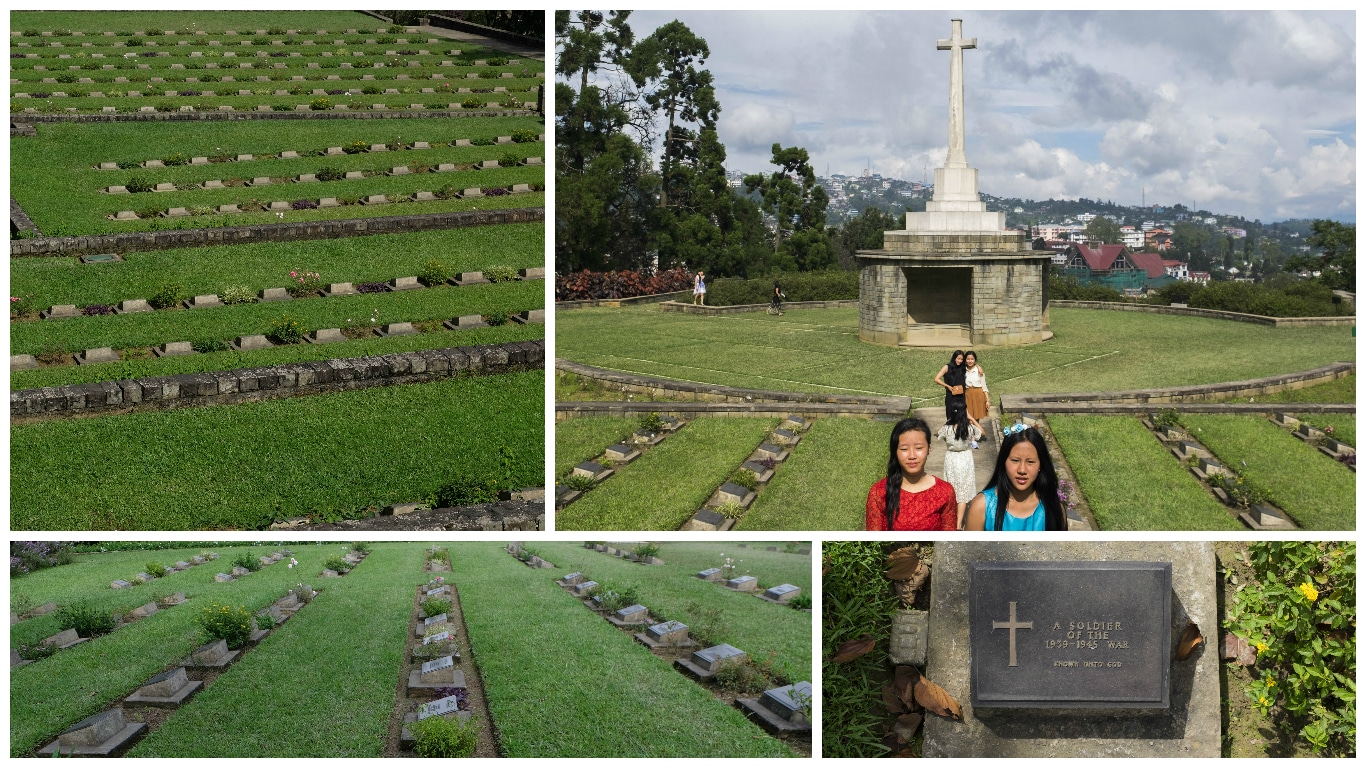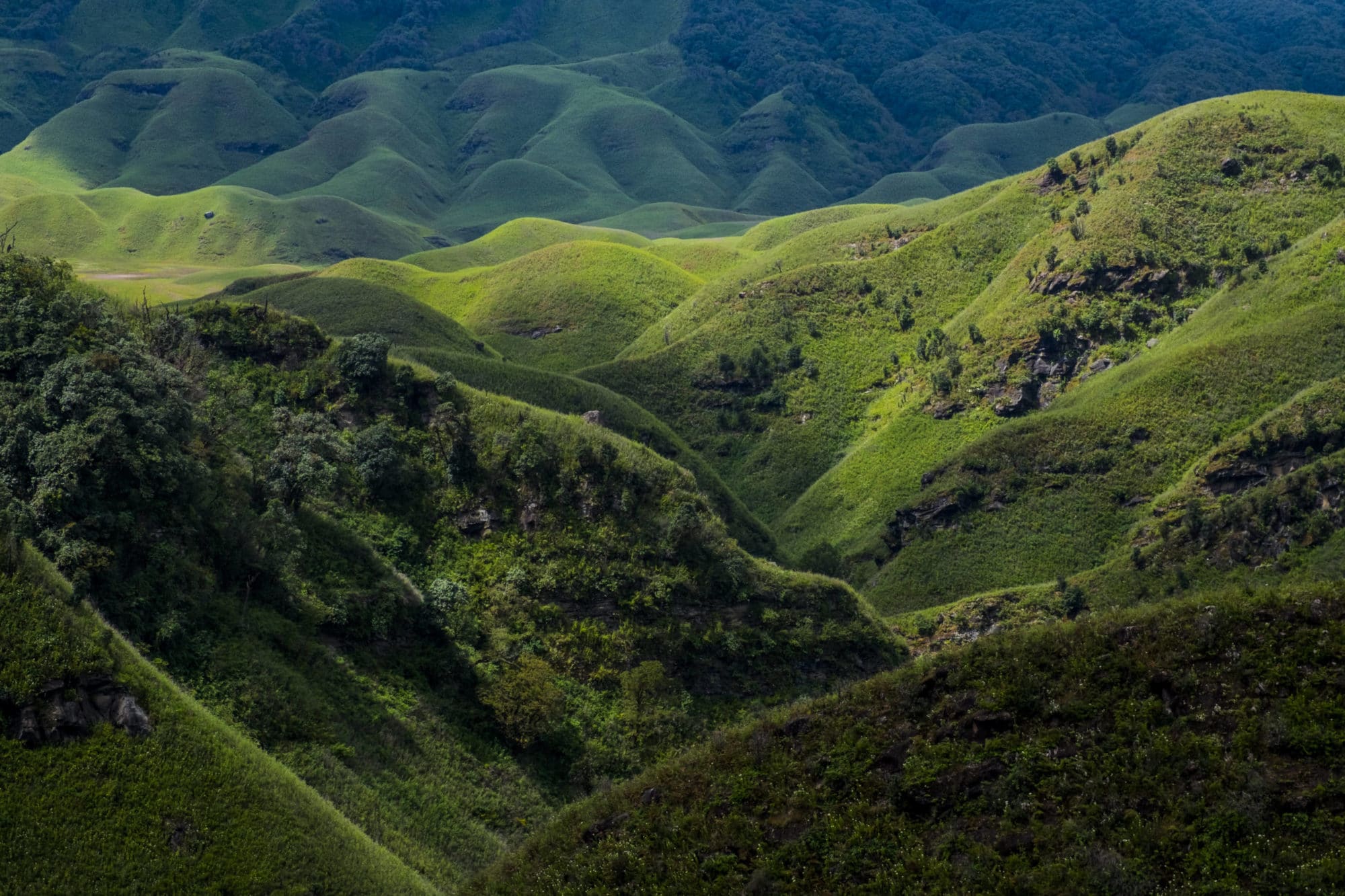Kohima is large and sprawling city, built over several ridges and hill tops. At first glance it seems like every other hill town, crowded, busy and full of traffic. But as Nagaland will teach you repeatedly, appearances can be deceptive; and this bustling hill town, an amalgamation of cultures and peoples from across the state, has a fantastic vibe and attitude that makes it worth spending a few days in. Unlike its counterparts in Himachal or Uttarakhand or even Sikkim, Kohima is a lot more laid back, begins and ends its days with the sun, and slowly grows on you. Because of several reasons, including a ban on vehicular movement for environmental reasons, no transport on Sundays and meeting friends, we ended up spending more time in Kohima than we had planned to and are quite happy we did so.

There are many reason to enjoy the city, from its amazing food including a culinary expedition across different tribes, to the number of day trips one can take from the city, to the markets that are nothing short of fascinating! Kohima is a great introduction to the rest of the state and somewhat prepares you for the adventure that is Nagaland.
Kohima can seem really confusing at first, but it’s quite easy to figure out once you spend a couple of days in the city. There is one main road that runs through pretty much the entire city (though off the main road there are mazes of smaller lanes, which are usually better to use during peak traffic hours) which is basically Highway No. 2. Branching off from this road starting at the southern end is the famous Kohima Cathedral, the War Cemetery at TCP Junction, the Naga Bazaar where you can buy everything from eels and snakes to fish and vegetables, and Kohima Village. This entire stretch can be walked, and will probably take half the day at a leisure pace. Further North from Kohima Village is the newer part of the city with a few fancy hotels, government buildings, commercial activity and the State Museum, well laid out and informative, with a superb collection of photographs depicting the history of the state. Both the cathedral and the war cemetery are not to be missed, for very different reasons, and if your stomach can hold itself down, then we recommend a wander around the Naga Bazaar.

The mammoth Kohima Cathedral, which dominates the skyline and can be seen from several vantage points, is a unique study in Christianity in Nagaland. Built in the late 1980s, the Roman Catholic church contains elements of several types of Naga homes, including the outside façade with a slanting triangular roof. The architecture is fairly unique and not like a Catholic church one might see in Southern India or in Europe; it is simple with only a few statues and paintings on the inside, rows of wooden pews and a stark feeling not unlike many homes we’d seen. The church was built largely through donations from the Japanese who wanted to construct a monument in memory of Japanese soldiers who died during WWII in Kohima, of which there were many. The WWII cemetery doesn’t have any graves of Japanese soldiers but the number of graves of Indians and British and other allied soldiers tell a gruesome tale.

The War cemetery is situated on Garrison Hill, the site of one of the fiercest battles during the war. The cemetery, maintained by the Commonwealth War Graves Commission, is now quiet and peaceful, with row and rows of gravestones of men from the 2nd British Division of the Allied forces who died fighting the Japanese Imperial Army. There are about 917 Hindu and Sikh soldiers and 1420 commonwealth soldiers with men from as far away as Wales and Australia. Standing there in the midst of these men, some as young as 17, it makes you wonder what propelled them to fight an unknown enemy in an unknown land, so far away from life and family, a fight that wasn’t theirs. We asked this question of the few remaining Nagas who fought in WWII, whom we had met in far flung villages, but that’s a story for another time. A solemn place, the war cemetery left us wondering further about this important part of history that is intertwined with the history of Nagaland and India, and why it hasn’t received adequate space in conversation and discourse today. As we walked away from Garrison Hill, which overlooks a large part of the city, a group of young kids came by, all dressed up celebrating the end of their exams, infusing the space with energy and new life.

A short walk down from the cemetery is the famous bazaar, which sells everything including snakes and eels, a variety of worms and bee larvae, regular vegetables and meats, fish of several sizes and the usual assortment of household necessities. Many stall owners, well dressed women in fashionable western wear, tried to sell us the exotic and the creepy, but we were content to walk around and take photos, marvelling at the sheer range of what is eaten in the city. Most restaurants and cafes don’t sell anything other than what one would expect, a lot of pork, beef, chicken and vegetables, the food we saw in the markets is mostly cooked in people’s homes. The market is at once fascinating, daunting, smelly and gross (especially if you are a vegetarian or animal lover), and sections are not for those with a weak stomach, but if you can get past all that it’s worth a visit to experience and understand a part of Naga culture, that adds to the melting pot that is India. And if you are lucky you might just catch a local football match at the stadium next door, with high pitched excitement and a lot of cheering.

Kohima, above all, is a culinary experience, and while there might not be much to do in the city, there is a lot of food to be sampled, giving you a small introduction and window into the yummy Naga cuisine. While you get different food across the state made unique by each tribe, you can sample some of the them in Kohima if you are unlikely to traverse across the state. While the Lotha tribe claims to have the best bamboo dishes, and the Zeliang tribe introduced the famous Raja Chilli to the cuisine and the world and the Sema tribe have perfected the art of cooking with fermented soy, all food is awesome and worth a little experimentation. Some of our favourite dishes included Anishi, a black gravy made from smoked and fermented yam leaves which is an Ao specialty; Axione, made of fermented soy which can be eaten with meat; simple Naga pork and bamboo shoot curry with rice; and all the different momos we ate in almost every single eatery. A lot of dishes have boiled squash or other leaves and fern served with them so you get your veggie quotient for the meal, and some are even served with plain bland lentils to balance the spice. Most of the food is boiled and lightly cooked, ginger and garlic are key ingredients, and none of it is heavy in ground spice or masala. What we didn’t like was the Naga version of noodles or chow as it’s called, many places serve it with a thick red sauce, and it is something that can be missed. One of our favourite restaurants is right next to the back entrance of the cathedral, a place called Where’s The Food, The Naga Diner. The proprietors, a brother sister duo, are lovely and very helpful and gave us one of the best meals we’d had in the city.

Kohima was one of those surprise places, which we’d ended up enjoying a lot more than expected and there is much there to keep you busy and entertained. However, if cities are not so much your scene then catch the morning bus or taxi and make a trip down to any number of villages that surround Kohima which will give you a feel of life in rural Nagaland. For a day trip one can visit the villages of Khonoma, Kisama or Kigwema all of which have brilliant views and offer a good walk around. If you want to meet people and go into homes for a more immersive experience, ensure that you engage a local guide. If you want to stay in a village to get a real feel of Naga life, Phusachodu and Benrue are good options for a couple of days. There are also good trekking options around Kohima, including the beautiful and surreal Dzukou Valley, which is really a must do, or for the more advanced trekker, a night climb up to Japfu peak offers some stunning sunrise views.

So if you find yourself in Kohima with a few days to spare, fear not, there is much to keep you busy and entertained. Try and get there over a weekend, to take in some of the famed music that the state is famous for at Ozone Café or Dream Café, or simply wander some of the smaller quieter neighbourhoods to catch some tunes out of people’s homes. And once you’ve had your fill of big city life, catch the bus to taxi and head off to explore the Nagaland, the journey of a lifetime.

Some Useful Information:
Where to Stay: Kohima has a range of stay options, from the higher end places like Aradura Inn which offers good city views to the cozy and homely Morung Lodge where Nino and Aman are a wealth of information about Nagaland. We stayed at Morung, which is a great backpacking option with good homemade food. Other options include the new and expensive Vivor Hotel, the charming but aging Governors Bungalow and the quirkily decorated and comfortable Razhu Pru.
Where to eat: Check out Where’s My Food next to the Cathedral for some excellent pork and duck curries. Orami next to NSF Martyrs Park also serves authentic Naga cuisine with a modern take. If you fancy some regular café food and Momos check out Dream Café (which also has live music on Friday nights) and Ozone Café. If you are pining for more ‘Indian’ food or are looking for a drink check out Aradura Inn’s extensive menu (the onion and beef steak is different and highly recommended) or sit by the large picture windows, take in the views of Kohima and sip on your poison.
Don’t Miss: The War Cemetery, the State Museum, the trek up to Dzukou Valley and a visit to Khonoma village along with some Pork delicacies are not to be missed.

2 Comments Add yours